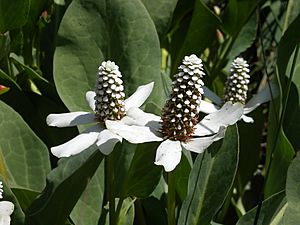Anemopsis facts for kids
Quick facts for kids Anemopsis |
|
|---|---|
 |
|
| Scientific classification | |
| Genus: |
Anemopsis
|
| Species: |
californica
|
| Synonyms | |
|
|
Anemopsis californica, also known as yerba mansa or lizard tail, is a special plant. It is the only species in its group, called Anemopsis.
This plant is a perennial herb. This means it lives for more than two years. It belongs to the lizard tail family, called Saururaceae. Yerba mansa loves very wet soil or shallow water.
Contents
Where Yerba Mansa Grows
Yerba mansa is found in North America. It grows in the southwestern parts of the United States. You can find it from California to Oklahoma and Texas to Kansas. It also grows north into Oregon and in northwest Mexico.
What Yerba Mansa Looks Like
Leaves and Stems
As the yerba mansa plant grows, its stems and leaves change color. They start to get red spots. By the fall, the whole plant can turn a bright red color. This makes it easy to spot!
Flowers and Seeds
Yerba mansa looks very pretty in the spring when it blooms. Its white "flowers" are actually special groups of tiny flowers. These groups are called pseudanthia. They are surrounded by 4 to 9 large white leaves, called bracts.
Just like the sunflower family, what looks like one big flower is many small flowers packed together. In yerba mansa, these tiny flowers form a cone shape. The large white bracts underneath make the whole plant look amazing when it blooms. After blooming, the cone turns into a tough fruit. This fruit can float downstream, helping to spread its tiny, pepper-like seeds.
What's in a Name?
The name "yerba mansa" is interesting. "Yerba" is a Spanish word for "herb." You might think "mansa" is also Spanish. But it's not! In Spanish, "mansa" means calm or peaceful. However, this plant doesn't make people feel calm. It was never used for that.
Yerba mansa is mainly used to fight germs. It can help against bacteria and fungi. Experts believe "mansa" might be a Spanish version of an old native word. This original word is now lost. The name "yerba del manso" is also used. "Manso" could also come from "remanso," which means "backwater." This makes sense because the plant grows in wet, still water areas.
How People Use Yerba Mansa
Medicinal Uses
Yerba mansa is known for its healing properties. It is used as an antimicrobial and antibacterial remedy. This means it can help fight off tiny germs.
People use yerba mansa to help with many things:
- It can treat inflammation of the mucous membranes. These are the moist linings inside your body, like in your mouth.
- It helps with swollen gums and sore throats.
- A tea made from its roots can act as a diuretic. This helps the body get rid of extra water.
- It can treat rheumatic problems like gout. Gout happens when too much uric acid builds up, causing painful joints. Yerba mansa helps remove this acid.
- It can stop uric acid crystals from forming in the kidneys. This helps prevent kidney stones.
- A powder from the dried root can be put on infected skin. It helps with problems like athlete's foot or diaper rash.
Yerba mansa is very useful. You can drink it as a tea or tincture. You can also take it in capsules. For outside use, you can soak inflamed areas in it. It can also be ground into a powder. Some people use its leaves to make a poultice. This is a soft, moist mass put on the skin to help with muscle swelling.
Crafts and Decorations
Yerba mansa is not just for medicine. It's also used in crafts!
- Its dried flowers are pretty in dry flower arrangements.
- Dried parts of the plant, like leaves and flowers, have a spicy smell. They are used in potpourri to make rooms smell nice.
Gardening Uses
In places like the deserts of California, yerba mansa is used in gardens.
- It can be planted as turf in parks.
- It also works well as a ground cover in home gardens. It's a good choice because it can handle dry conditions.
See also
 In Spanish: Anemopsis californica para niños
In Spanish: Anemopsis californica para niños


